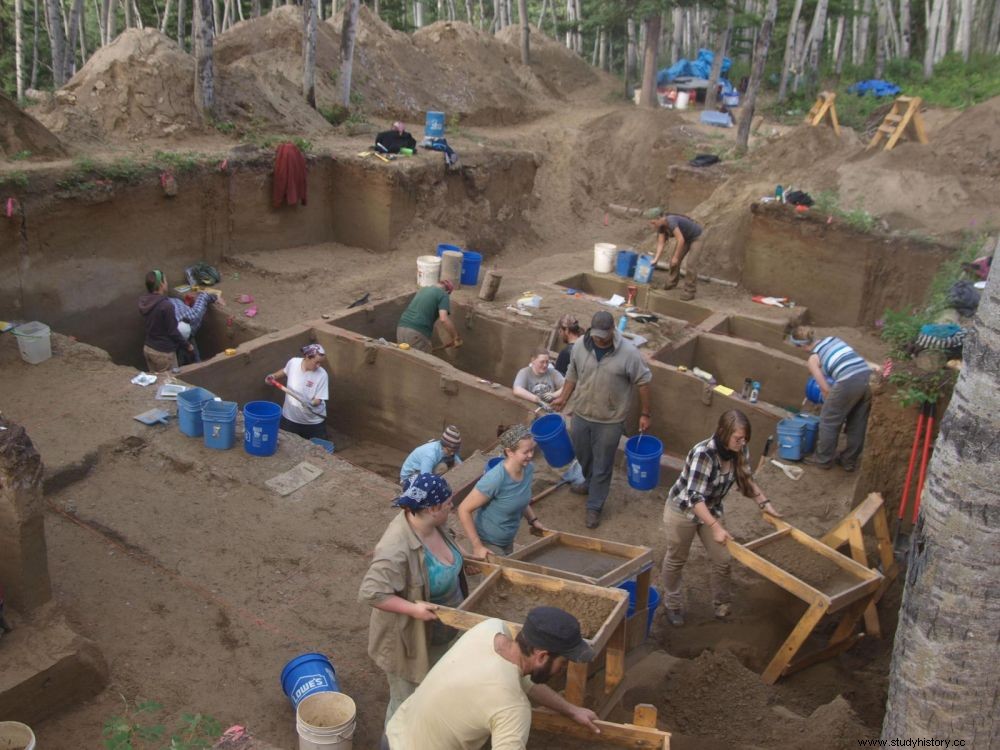Genome sequencing of an 11,500-year-old girl reveals the existence of a previously unknown ancient population in America. It confirms the long-debated hypothesis that the continent was populated via the Bering Strait, between Siberia and Alaska.

The discovery of a prehistoric fetus and infant at the Upward Sun River archaeological site (western Alaska) dates back to 2013.
BERING. It's an ancient riddle in the history of Homo sapiens that a team from the University of Alaska in Fairbanks seems to have solved. By analyzing the DNA of an infant of -11,500 years, the researchers have confirmed that the settlement of America was well done at least -20,000 years ago by the Bering Strait. Their study, published on January 4, 2018 on the Nature website , also reveals the existence of a previously unknown Native American population, which they named the Ancient Beringians (AB).
Prehistoric infant DNA has spoken
A look back at this great adventure:In 2013, a prehistoric fetus and infant were discovered at the Upward Sun River archaeological site, west of Alaska, in the United States. The local populations call them respectively "little girl of the gleams of dawn " and "little sunrise girl l ". They were covered with red ocher and buried in a circular pit, next to several primitive hunting weapons. According to carbon 14 dating, the bones date from -11,500 years ago. the six-week-old infant's DNA has persisted over time and therefore remains usable.According to Ben Potter, of the team that carried out the genome analyses, "the window into the past that these children provide is invaluable" .
To everyone's surprise, the baby studied does not belong to the groups of Native Americans, known as "South" and "North", hitherto considered the only branches of Homo sapiens present on the continent. USR1, the infant's alternative name used by scientists, represents a distinct new population dubbed "Ancient Beringians " . Using demographic modeling, the researchers inferred that the Ancient Beringians and the ancestors of other Native Americans descended from a single population, which broke away from East Asia 36,000 years ago. They separated entirely -22,000 to -18,000 years ago. In turn, the Native American group split again into two lineages (Northern and Southern) about 15,000 years ago. However, while we know the dates on which these separations took place, the team is still uncertain about the areas where they took place.

Migration of Homo sapiens from East Asia to America . Credits:Hannibal W. / Sciences et Avenir
With this study, scientists believe they have proof that Homo Sapiens took the land corridor offered by "Beringia" to reach American soil. Beringia was, tens of thousands of years before our era, an area located between Siberia and Alaska. Since then, the water level has risen and covers what is now known as the Bering Strait.
A passable corridor
According to the most commonly accepted theories, humans would have reached the American continent by taking this formerly clear route, according to migrations. However, some archaeologists and anthropologists refute this hypothesis. For them the corridor was not passable -20,000 years ago because of huge blocks of ice that prevented access to the continent.
In 2016, a team suggested another path, that of the Pacific. Along the coast, around -13,000, the first men could feed themselves easily by exploiting maritime resources.
Although the girl's study provided crucial information, the mystery surrounding the disappearance of the Ancient Beringians remains unsolved. The population has no direct descendants. The Athabascans, who currently live at the Upward Sun River, are rather descendants of native North Americans. Both children died in summer, the season when resources are believed to be abundant, suggesting a risky and delicate lifestyle. The Beringian line therefore probably died out, and it was only later that Native Americans moved north to settle there.
